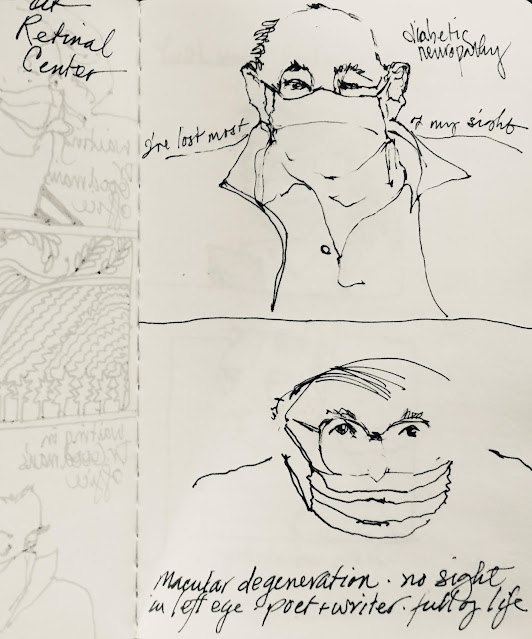 |
| Center page of my first BAL sketchbook |
Hope, like so many positive feelings, is fleeting. Think of laughter, joy, wonder, and how quickly they come upon us and just as quickly recede. We often remember every second of a regret, mistake, every feeling of sadness or anger, or misfortune. Somehow it is easy to write about these more somber emotions. That is what drama builds stories on, after all. Facebook bombards us with articles that stir these emotions. But hope is not so easy.
I thought of hope when a small brown package arrived yesterday. Inside another brown envelope contained a sketchbook from the Brooklyn Art Libary (BAL), a non-profit group that encourages people to sketch and to send in their sketchbooks to share with the world. They explain their project on the envelope:
"The Sketchbook Project is the world's largest library of artists' books, crowd-sourced from every corner of the globe. The project is changing the way creative people share their work while creating a worldwide community resource. By filling a sketchbook, you are joining the movement, adding your voice, and becoming a part of something huge. Draw, write, collage, cut, print, photograph -- it starts with an idea."
An idea is hope.
I ordered this latest sketchbook because I thought my COVID Diary could fill the pages of the sketchbook. By sending the book to the library, my diary becomes more than the story of a year and a half of my life. My book becomes part of a universal experience.
 |
The word LAUGH. Can you find it?
A sketch made during An Vanhentenrijk's FOC workshop last weekend.
|
Several years ago, I ordered another sketchbook that I haven't completed. Unlike the other BAL books, the Library asked people to write in a journal using one of two prompts. The journal I received said, "Hope." After a few pages, I got stuck. The book sits, unfinished, because I didn't want to write something treacly. I thought of Emily Dickinson's lovely line about hope being a thing with feathers that has become so overused.
I went back to the basics and made lists of what gives me hope.
Planting a tree: first, for the idea of longevity, then for the connection to another living being.
Babies: a new life in a very uncertain world. Don't we all wonder what the world will be like for our children? Yet, just this week, we celebrated the arrival of a new baby in our neighborhood.
Global natural events: a full eclipse of the sun brought out millions of people to watch. A full moon, especially a moon that rises closer to the Earth than usual.
A tree full of bees: first, because bees are disappearing at an alarming rate, and second, a tree full of bees is a promise of what's to come.
A small plant rooted in a crack in the pavement: shows how tenacious the will to live can be.
And more: being present and listening to old friends and new acquaintances. The change in seasons.
The list is getting longer and I am now assured that I can fill the sketchbook with HOPE.
 |
| One of my mantras: SAY YES TO LIFE |
Check out the Brooklyn Art Library and look through digitized examples of the thousands of sketchbooks contained there:
https://brooklynartlibrary.org/mission
Would you like to try calligraphy? Check out the Friends of Calligraphy website:
https://www.friendsofcalligraphy.org
Check out An Van Hentenrijk's calligraphic gallery here:
http://www.anvanhentenrijk.be/galerij2.html




























